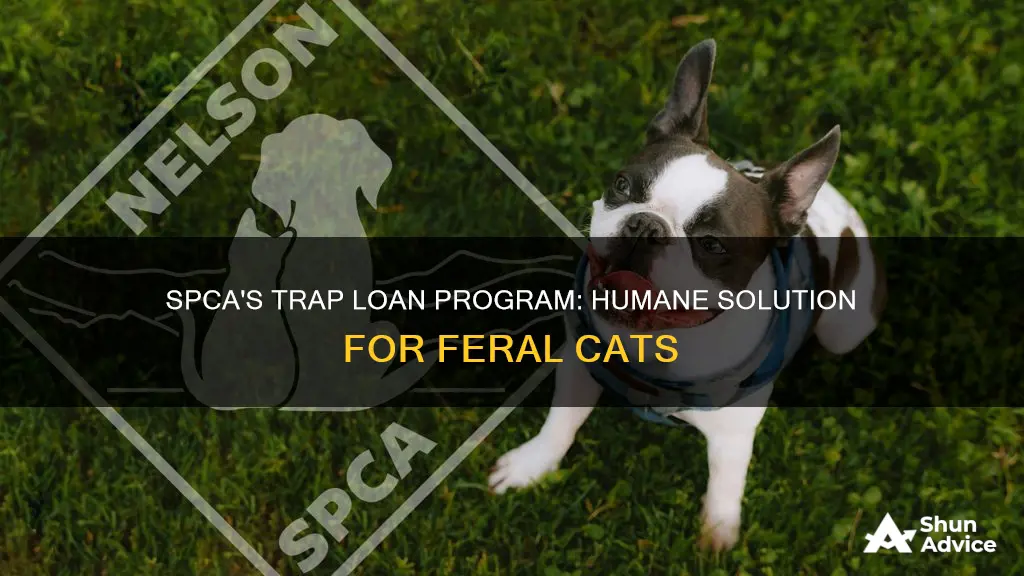
The SPCA, or Society for the Prevention of Cruelty to Animals, offers trap loan programs to help individuals humanely capture, neuter, and return feral cats to their colonies. This Trap-Neuter-Release-Maintain (TNRM) method aims to curb overpopulation and disruptive behaviours among street cats. SPCA branches, such as those in Sacramento, Jefferson Parish, and Montreal, provide these loan programs with specific requirements, rental fees, and guidelines to ensure the safe and responsible use of traps. The programs vary in their implementation, with some utilizing technology for better equipment tracking, while others offer free rentals with refundable security deposits. These initiatives play a crucial role in managing feral cat populations and promoting animal welfare within communities.
| Characteristics | Values |
|---|---|
| SPCA location | Sacramento SPCA, Jefferson SPCA, Montreal SPCA |
| Trap cost | $70, $87, $100, $125 |
| Deposit | $87, $100, $125 |
| Rental period | 2 weeks |
| Trap type | Tru Catch humane cat trap, gravity-activated trap cage |
| Trap purpose | Trap, Neuter and Return (TNR), Trap-Neuter-Release-Maintain (TNRM) |
| Trap requirements | Participating clinics, spaying/neutering appointment, feeding schedule, no animal shelters |
| Trap return | Clean, disinfected, newspapers removed |
What You'll Learn

SPCA's Trap-Neuter-Return (TNR) program
The Trap-Neuter-Return (TNR) program is a humane approach to managing community cat populations. SPCAs across the United States, such as the Sacramento SPCA, Jefferson SPCA, and York County SPCA, offer TNR programs to help reduce feral and stray cat populations and improve the lives of community cats.
Through the TNR process, community cats are humanely trapped and brought to a veterinary clinic to be spayed or neutered, vaccinated, and eartipped—a universal sign that the cat has been spayed or neutered through a TNR program. The cats are then returned to their outdoor homes, where they can live out their lives with their feline families. TNR effectively addresses the community cat population by ending the breeding cycle, preventing the birth of new kittens in community cat colonies.
SPCA's TNR programs often include trap loan programs to facilitate the trapping and neutering of community cats. These programs loan traps to individuals participating in TNR, with the requirement that the traps are only used for their intended purpose and not for capturing owned cats or any other unlawful purpose. A deposit is typically required for trap rental, which is refunded upon the return of the trap. Some SPCAs, like the York County SPCA, also offer live-release humane traps for rent, with a cash deposit that is returned when the traps are brought back.
The TNR program has been praised as a humane and effective approach to community cat management, reducing shelter intake and killing, saving taxpayer dollars, and improving relationships between cats and the people who live near them. It is a compassionate alternative to catch-and-kill policies, which are often cruel, ineffective, and opposed by the public. By spaying and neutering community cats, TNR helps to end the endless cycle of trapping and killing, providing a more sustainable solution.
Sallie Mae Loan App: Hard Inquiry or Not?
You may want to see also

Deposit requirements and fees
The Montreal SPCA also requires a deposit for its Trap-Neuter-Release-Maintain (TNRM) program. A $100 deposit is required to rent a trap cage, and a $30 deposit is required for a carrier. Both deposits will be refunded in full when the equipment is returned.
The Sacramento SPCA operates a similar program with a required deposit of $125 per trap, which can be made via check or credit card. This deposit is also refunded upon the return of the trap.
It is important to note that these programs are specifically for Trap, Neuter, and Return (TNR) initiatives and should not be used to capture owned cats or for any other unlawful purpose. The traps are intended solely for the spay/neuter procedures or other necessary medical treatments of feral cats.
Stimulus Package: EIDL Loans Included or Excluded?
You may want to see also

Trapping techniques
The SPCA advocates for specific trapping techniques to ensure animal welfare and humane treatment. They recommend the use of remote-sensing technologies with alert systems that notify operators when an animal is captured. This enables prompt response and reduces stress on the trapped animal. SPCA also emphasizes the importance of operator skill and trap placement to minimize the risk of capturing non-targeted animals.
Trap operators should be knowledgeable about trap maintenance, positioning, and the age of the trap to ensure effectiveness. The SPCA opposes the use of leg-hold and glue-board traps due to their negative impact on animal welfare and indiscriminate capture methods. Leg-hold traps are restricted under the Animal Welfare Act (Leg-Hold Traps) Order 2007, while glue-board traps are restricted under the Animal Welfare Act (Glueboard Traps) Order 2009. Exemptions can be granted by the Ministry of Primary Industries (MPI) in certain cases.
To effectively trap birds of prey and large birds, snappy snares, consisting of cable loops that close around the bird's leg, can be utilized. Proper installation, secure attachment, and regular monitoring are crucial to prevent escape and minimize harm. Underwater traps, such as cage traps and fyke nets, are suitable for capturing aquatic animals like muskrats, minks, and turtles. These traps are partially or fully submerged and baited to attract the target species.
Additionally, the SPCA supports trap loan programs for specific purposes, such as the Trap, Neuter, and Return (TNR) initiative for feral cats. These programs often require a deposit and have strict guidelines for usage, emphasizing that traps should not be used to capture healthy animals for euthanasia or surrender. Trap loan programs can be a valuable tool for community cat management and population control.
Missing Documents: Nelnet Loans and National Collegiate's Impact
You may want to see also

Trap identification and tracking
Trap Identification
To ensure the humane treatment of animals, trap loan programs like those offered by the Sacramento SPCA and Jefferson SPCA require that traps are used solely for Trap, Neuter, and Return (TNR) of feral or community cats. These programs emphasise that traps must not be used to capture owned cats or for any unlawful purpose, such as capturing healthy animals for euthanasia. To further ensure the ethical treatment of animals, some organisations, like SPCA de l'Outaouais, implement universal identification methods. They notch the left ear of a cat post-neutering and tattoo a line of green ink on the abdomen of sterilised females. These measures prevent the same cat from being trapped and neutered multiple times.
Trap Tracking
Trap loan programs can have dozens of traps in circulation, with multiple people involved in the lending process. This makes it challenging to keep track of the traps. Organisations like the Feral Cat Coalition of Oregon (FCCO) have implemented technological solutions, such as using barcodes or QR codes, to track their traps effectively. They assign each trap a unique barcode or QR code, which is then scanned whenever the equipment is borrowed or returned. This helps streamline the trap loan process, making it easier to manage and reducing the chances of traps being lost or unaccounted for.
To further improve trap tracking, organisations can implement measures such as requiring security deposits, which are refunded upon the timely return of the traps. Additionally, having clear guidelines for trap usage, including expectations for trap cleanliness upon return, helps maintain the condition of the traps and encourages timely returns.
By focusing on effective trap identification and tracking, organisations can ensure the responsible and ethical use of their equipment, contributing to the overall success of their trap loan programs and the well-being of the animals they aim to help.
Understanding the Paycheck Protection Loan Repayment System
You may want to see also

Trap cleaning and maintenance
The Sacramento SPCA, Jefferson SPCA, and Feral Cat Coalition of Oregon (FCCO) are among the organizations that loan traps to individuals who participate in TNR (Trap, Neuter, and Return) programs. These programs aim to reduce cat overpopulation by encouraging the trapping, neutering, and returning of cats to their home colonies. While the traps are typically loaned free of charge, a refundable security deposit is often required to ensure the traps are used for their intended purpose and returned in a clean and functioning state.
Trap Cleaning:
- Inspect the trap's parts: Before beginning the cleaning process, it is important to understand the trap's components and their locations. Remove the lid slowly and gently to protect any gaskets. Take a picture or draw a diagram of the interior to aid in reassembling the trap later.
- Measure the waste level: Insert a wooden dowel or a measuring stick into the trap and swirl it gently to mark the level of grease and oils. Remove the dowel and use a tape measure to determine the amount of waste present. Record this measurement in a Fatty Oils and Grease (FOG) report provided by the Environmental Protection Agency (EPA).
- Remove standing water: Use a small bucket or a pump to remove any standing water from the trap and set it aside. If desired, this water can be poured back into the drain after cleaning.
- Scrub and flush the trap: Wear gloves and use a steel pot scrubber with soap and water to scrub the trap and remove built-up grease and debris. Flush the screens and parts with water to eliminate soap residue and leftover waste.
- Reinstall the parts: Once the trap is clean and dry, refer to the picture or diagram taken earlier to correctly reinstall all the components. Ensure the trap is fully functional and blockage-free by draining a gallon of clean water through it.
- Dispose of waste properly: Collect all the waste, including the soapy water used for cleaning, in a double-lined garbage bag for proper disposal. Do not pour this waste down the drain as it can cause clogs and other issues.
Trap Maintenance:
- Regular cleaning: Maintain a regular cleaning schedule for the traps to prevent foul odors, clogs, and overflows. Depending on usage and local regulations, a thorough cleaning may be required at least once every 90 days.
- Avoid chemical cleaners: Do not use bleach, emulsifiers, enzymes, or heavy-duty chemical cleaners in the trap as these can kill the natural bacteria that break down FOG. These substances often only separate FOG from wastewater, leading to potential clogs.
- Record-keeping: Keep accurate records of trap usage, cleaning dates, and FOG reports. This information is crucial for compliance with environmental regulations and can help track the condition and location of traps.
- Identify your traps: Clearly mark all traps as your organization's property to facilitate proper returns and reduce losses. This can be done through barcodes, QR codes, or other unique identifiers.
- Staff training: Ensure that staff and volunteers are trained in the proper use, cleaning, and maintenance of the traps. This includes understanding the importance of regular cleaning and the potential consequences of improper trap management.
Jumbo Loan Size: Expansion and Impact on Borrowers
You may want to see also
Frequently asked questions
The SPCA offers a trap loan program to individuals who participate in TNR (Trap, Neuter, and Return). The program aims to reduce cat overpopulation by encouraging the trapping, neutering, and returning of cats to their home colonies.
To borrow a trap from the SPCA, you must have a spay/neuter appointment scheduled with one of their participating clinics. You will also need to provide a refundable security deposit, which will be returned when the trap is brought back.
The SPCA's loaned traps must only be used for the Trap-Neuter-Return of feral or community cats. These traps cannot be used to capture owned cats or for any other unlawful purpose. Captured cats cannot be brought to shelters or relocated and must be returned to their original location.







